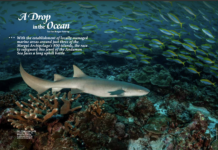Making carbon a thing of the past
By Selina Tan
Additional Information City Developments Limited
The Maldives is ground zero when it comes to climate change. It is the lowest-lying country in the world, with an average elevation of just 1.5 metres above sea level. If global carbon emissions continue unchecked, much of the 1,200-island archipelago – famed for its white-sand beaches and azure-blue waters – could be submerged by the end of this century.
Diesel engines drive almost everything in the Maldives, from the ferries that run between the country’s islands to the electric generators that provide power for its 350,000 citizens. This island nation spends a good 15 percent of its GDP on diesel (the standard benchmark being at 4 percent of GDP, the amount the US spends on petroleum). However, the government is determined to change that. Research and investment into renewable energy has been growing since the country’s president declared five years ago that the Maldives would go carbon neutral by the year 2020 – in the hope that, by leading by example, the rest of the world would follow suit.
Low-lying and densely populated, Singapore is also at risk from the adverse impacts of climate change. These include coastal land loss, struggles with water resources, public health implications from the resurgence of diseases, heat stress, and threats to marine biodiversity.

While Singapore accounts for less than 0.2 percent of global greenhouse gas (GHG) emissions, it’s per-capita emissions are similar to other industrialised nations. The island nation’s key strategy for reducing its carbon footprint is to improve energy efficiency in all sectors, namely transport, households, industry and buildings. Buildings, in particular, contribute to approximately 16 percent of Singapore’s national GHG emissions. This is where corporate organisations are stepping in to reduce their carbon footprint.
Adopting energy efficiency measures and switching to renewable energy are imperative components of the solution to reducing global carbon emissions. Still, in the course of making buildings more energy efficient and driving or flying less often, it is nearly impossible to bring this number down to zero.
Carbon neutrality requires that we offset unavoidable emissions. One way to do this is by paying for GHG reductions to be made elsewhere, such as via tree planting, wind farms and hydroelectricity. The idea is that once enough offsets are purchased to balance all emissions remaining after reduction efforts, then the net emissions will be zero.

Carbon offsetting is fundamentally a market-based mechanism and is typically transacted in metric tonnes of carbon dioxide equivalent (tCO e). Purchasing one tonne of carbon offset means there will be one tonne less of carbon dioxide (or an equivalent GHG) in the atmosphere than there would otherwise have been. Offset buyers can choose to support carbon-offset schemes that possess an inherent value unique to the project type (for example, reforestation) or country location. Such projects deliver certain environmental, economic and community or social advantages. Non-carbon benefits include new infrastructure or biodiversity enhancement benefits.
An organisation can claim “carbon neutrality” as long as it can demonstrate that it has firstly properly calculated and accounted for its GHG emissions and offset them so that net emissions from its business activities equal zero. City Developments Limited (CDL), one of Singapore’s largest real estate companies and green developers, set a milestone in environmental sustainability with the establishment of 11 Tampines Concourse, unveiled in 2009, as a certified carbon-neutral development – a first in Singapore and the Asia Pacific.
Tampines Concourse’s carbon emissions were reduced to “net zero” by offsetting some 6,750 tCO e for 2009 – the total estimated tCO e generated during the construction phase and for the first year of operations. This was accomplished with the buying of carbon credits that fund carbon-offsetting projects in Asia.

Beyond sustainable design and eco-friendly features for energy and water efficiency, concerted efforts were made to introduce inventive building materials such as “green” concrete, a structural component comprising materials like copper slag, recycled concrete aggregates, and ground granulated blast furnace slag – all in a bid to cut down significantly on carbon-dioxide emissions. As a result, the 10,000-square-metre Tampines Concourse is estimated to reap overall energy savings of 620,000 kWh per year, which is equivalent to an estimated reduction of an impressive 325 tCO e annually.
CDL also strongly promotes the use of electricity directly from the power grid through a substation at the construction stage whenever possible, which also results in lower emissions of GHGs, sulphur oxides, nitrogen oxides and particulates.
CDL’s renewed corporate social responsibility objectives in the environmental, health and safety area encompass ensuring the maintenance of an international management system for the environment and achieving an industry leadership position in green buildings in Singapore. CarbonNeutral® certification has made Tampines Concourse the ideal office address for like-minded businesses looking to enhance their position as eco-conscious companies.

The process of attaining CarbonNeutral® development status was facilitated by an Australia-based firm, The CarbonNeutral Company, one of the world’s leading carbon offset and carbon management companies with a proven track record of working with 300 large organisations and 200 carbon offset projects across six continents. Underpinned by a well-recognised standard known as the CarbonNeutral Protocol, every tonne of carbon sold by The CarbonNeutral Company is guaranteed. Buying offsets located in developing countries reaps healthy dividends in terms of supporting the transition to clean, renewable energy and avoiding the high-emissions path of developed nations.
The carbon credits CDL has purchased under this scheme supplies funding to a number of projects in Asia, such as the Dalian Landfill Gas Project and the Tieling Coal Mine Methane, both in China. Without the injection of carbon finance, these projects would be unviable. Beyond creating obvious climate benefits, these proposals also bring about social benefits, such as employment and training opportunities, as well as improving the quality of life
of the local community.
For more stunning stories and photographs from this issue, check out Asian Geographic Issue 111.











